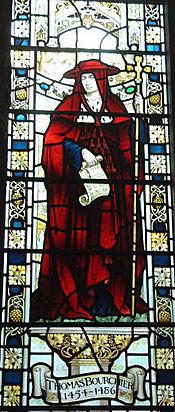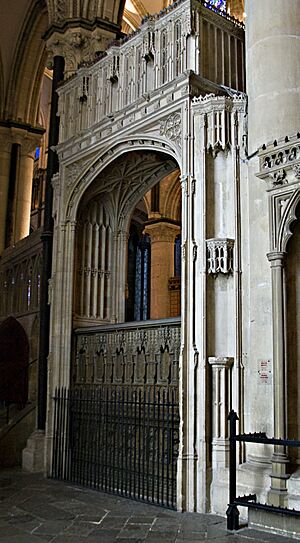Thomas Bourchier (cardinal) facts for kids
Quick facts for kids His Eminence Thomas Bourchier |
|
|---|---|
| Cardinal, Archbishop of Canterbury Primate of All England |
|

1909 stained glass depiction in Sevenoaks Church, Kent, of Thomas Bourchier, wearing a cardinal's galero (a broad-brimmed hat). His residence of Knole House, which he built, was situated opposite the church
|
|
| Appointed | 23 April 1454 |
| Enthroned | 26 January 1455 |
| Reign ended | 30 March 1486 |
| Predecessor | John Kemp |
| Successor | John Morton |
| Orders | |
| Ordination | 1433 |
| Consecration | 15 May 1435 by Henry Beaufort |
| Created Cardinal | 18 September 1467 |
| Rank | Cardinal priest |
| Personal details | |
| Born | 1404 |
| Died | 30 March 1486 Knole House |
| Buried | Canterbury Cathedral |
| Nationality | English |
| Denomination | Roman Catholic |
| Education | University of Oxford |
| Coat of arms |  |
Thomas Bourchier (born 1404, died 30 March 1486) was an important English leader during the Middle Ages. He held very high positions in both the church and the government. He was a Cardinal, the Archbishop of Canterbury, and even the Lord Chancellor of England.
Contents
Early Life and Education
Thomas Bourchier was born in 1404. He came from an important family. His father was William Bourchier, and his mother was Anne of Gloucester. Anne was the daughter of Thomas of Woodstock, who was the youngest son of King Edward III. This means Thomas Bourchier was related to the royal family.
He went to the University of Oxford for his education. After finishing his studies, he decided to join the church. He quickly moved up in his career.
A Career in the Church and Government
Thomas Bourchier started with smaller roles in the church. He was made the Bishop of Worcester on May 15, 1434. In the same year, he also became the Chancellor of the University of Oxford. This was a very important job at the university.
In 1443, he was chosen to be the Bishop of Ely. Then, in April 1454, he became the Archbishop of Canterbury. This is the most senior leader of the Church of England. A year later, in March 1455, he also became the Lord Chancellor of England. This made him the most powerful official in the government.

Role in the Wars of the Roses
Thomas Bourchier's time as Lord Chancellor happened at the start of the Wars of the Roses. This was a series of civil wars in England. At first, he tried to stay neutral. However, he lost his job as chancellor in 1456. This happened when Richard Plantagenet, 3rd Duke of York, lost his power.
In 1458, Bourchier tried to help make peace between the two sides. This event was called The Love Day. But when the war started again in 1459, he chose to support the House of York. He crowned Edward Plantagenet, 4th Duke of York as King Edward IV in June 1461. Four years later, he also crowned Edward's queen, Elizabeth Woodville.
Later Achievements
In 1457, Bourchier led the trial of Reginald Pecock, who was the Bishop of Chichester. Pecock was accused of heresy, which means holding beliefs that go against the official church teachings.
In 1473, Thomas Bourchier was made a Cardinal. This is a very high rank in the Roman Catholic Church. King Edward IV had asked for this honor for him back in 1465. In 1475, he helped arrange the Treaty of Picquigny between England and France. This treaty helped to end a conflict between the two countries.
After King Edward IV died in 1483, Bourchier played a role in the events that followed. He convinced the queen to let her younger son, Richard of Shrewsbury, 1st Duke of York, join his older brother King Edward V in the Tower of London. The Tower was supposed to be a safe place for them. Even though Bourchier had promised to be loyal to King Edward V, he later crowned King Richard III in July 1483.
Thomas Bourchier crowned a third English king, Henry VII, in 1485. He also performed the marriage ceremony for King Henry VII and Elizabeth of York in January 1486.
Death and Burial
Thomas Bourchier passed away on March 30, 1486. He died at Knole House, a large home near Sevenoaks in Kent. He had made many changes to this grand residence. He was buried in Canterbury Cathedral, where you can still find his monument today.
Images for kids



